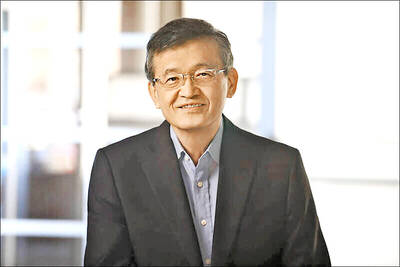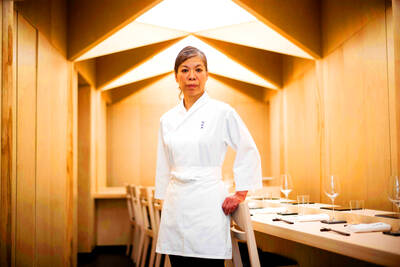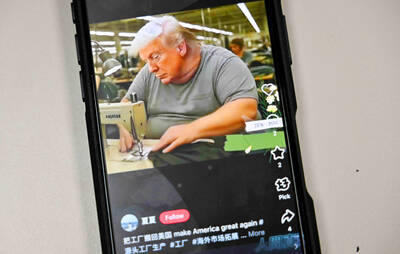Non-fungible tokens (NFTs), the identifiers of the crypto world linked to digital artworks, have been granted a show at the Centre Pompidou in Paris, despite an almost total collapse in their price and cultural cachet.
The Pompidou, a popular attraction in the Marais district of the French capital, has opened the exhibition in its minimalist halls dedicated to NFTs, which could give the digital art form a much-needed lift.
Blockbuster multimillion-dollar sales helped fuel publicity in 2021, and prices soared amid a lack of regulation and general confusion over what the digital tokens were.

Photo: Bloomberg
However, the value of NFT transactions fell 94 percent from 2021 to last year, from US$233 million to US$14 million, French analytics firm Artprice said.
The organizers of the event at the Pompidou, the first European gallery to start a collection of NFT art, are more keen to talk about the art than the economics.
“These artists get a place in the history of art and their works are guaranteed longevity,” the gallery’s chief curator Marcella Lista said.
The collapse in interest in NFTs along with a wider plunge in the value of cryptocurrencies allowed the Pompidou to bag many of the works for just a handful of dollars, records on the OpenSea platform showed.
About half of the pieces were donated by their creators.
Among those who happily handed over their art was Californian artist Robness, who came to see the show and said it was a “humbling experience” to be included.
He, too, was eager to shift the focus from the slump in prices.
“If you start worrying about the market dynamics, you’re taking your energy out, putting it into other places,” he said.
“That’s not conducive to actually creating,” he added.
Robness compared NFTs to e-mail, an elemental technology that he said would continue to find uses.
Born at the crossroads of technology and artistic provocation, NFT art quickly created its own emblems and myths — and the Pompidou exhibition is steeped in its iconography.
Robness donated a 3D “portrait” of Satoshi Nakamoto, the possibly fictional creator of bitcoin.
Another of the works on display is Bitchcoin, a representation of a bitcoin created by Sarah Meyohas in 2015, making it one of the first NFT artworks.
While one of the most famous emblems of the scene, a “cryptopunk,” also gets an airing.
Visitors have the experience of a traditional art gallery — whitewashed walls, hanging images accompanied with small explanation cards — but instead of canvas and paper, the digital works are rendered on screens.
If the prices paid for the artworks were surprisingly low, the gallery nonetheless had to jump through some pretty tight hoops to acquire them.
NFT art is generally sold on platforms where cryptocurrency is the preferred payment method, and proof of ownership is stored on the blockchain.
Lista said that accounting rules simply would not permit the Pompidou to go through the convoluted process of buying cryptocurrency to acquire the works, and blockchain records were not good enough.
Instead, the works were paid for in euros and contracts were signed under French law, she said.
Then comes the difficulty of storing and insuring the works, which are essentially digital pixels that can be replicated as many times as anyone wants.
Philippe Bertinelli, also a curator of the exhibition, said that copies were held on several servers and in different media.
“Even if a system breaks down or something is lost or burned, we can ensure the works are still safely stored,” he said.

Intel Corp chief executive officer Lip-Bu Tan (陳立武) is expected to meet with Taiwanese suppliers next month in conjunction with the opening of the Computex Taipei trade show, supply chain sources said on Monday. The visit, the first for Tan to Taiwan since assuming his new post last month, would be aimed at enhancing Intel’s ties with suppliers in Taiwan as he attempts to help turn around the struggling US chipmaker, the sources said. Tan is to hold a banquet to celebrate Intel’s 40-year presence in Taiwan before Computex opens on May 20 and invite dozens of Taiwanese suppliers to exchange views

Application-specific integrated circuit designer Faraday Technology Corp (智原) yesterday said that although revenue this quarter would decline 30 percent from last quarter, it retained its full-year forecast of revenue growth of 100 percent. The company attributed the quarterly drop to a slowdown in customers’ production of chips using Faraday’s advanced packaging technology. The company is still confident about its revenue growth this year, given its strong “design-win” — or the projects it won to help customers design their chips, Faraday president Steve Wang (王國雍) told an online earnings conference. “The design-win this year is better than we expected. We believe we will win

Chizuko Kimura has become the first female sushi chef in the world to win a Michelin star, fulfilling a promise she made to her dying husband to continue his legacy. The 54-year-old Japanese chef regained the Michelin star her late husband, Shunei Kimura, won three years ago for their Sushi Shunei restaurant in Paris. For Shunei Kimura, the star was a dream come true. However, the joy was short-lived. He died from cancer just three months later in June 2022. He was 65. The following year, the restaurant in the heart of Montmartre lost its star rating. Chizuko Kimura insisted that the new star is still down

While China’s leaders use their economic and political might to fight US President Donald Trump’s trade war “to the end,” its army of social media soldiers are embarking on a more humorous campaign online. Trump’s tariff blitz has seen Washington and Beijing impose eye-watering duties on imports from the other, fanning a standoff between the economic superpowers that has sparked global recession fears and sent markets into a tailspin. Trump says his policy is a response to years of being “ripped off” by other countries and aims to bring manufacturing to the US, forcing companies to employ US workers. However, China’s online warriors